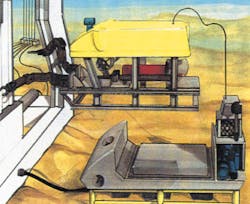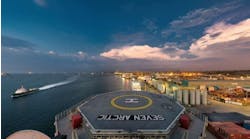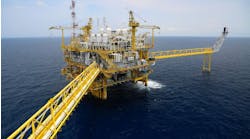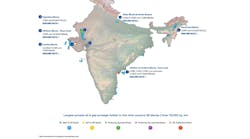Avoiding surface umbilicals, support costs
Artist's impression of the Swimmer in AUV mode, connected by a leash to the BAT skid.Traditionally, the offshore industry has been skeptical of autonomous underwater vehicles (AUVs). However, the use of remotely operated vehicles (ROV) in ultra-deepwater fields can be both expensive and problematic. A new project spearheaded by Marseille-based Cybernetix aims to demonstrate that standard ROVs can be used in an AUV mode for delivery from the surface to the deepwater work site, thereby overcoming the need for very long and heavy umbilicals, special support vessels, and their associated costs.
All components of the Cybernetix-developed Swimmer (subsea works, inspection and maintenance with minimum environment ROV) system have been developed and tested by Cybernetix and partners in separate programs.
The Swimmer offers an alternative to conventional surface vessel/umbilical/ROV architecture. The basic ideas behind the concept is to use the existing pro duction umbilical to supply the ROV with power and signal transmission.
System assembly
First, a standard-construction ROV is fitted with a dedicated tool-skid comprising essentially a battery pack, acoustic tele trans mis sion system and a tether management system (BAT skid). Then the ROV is tele-operated to its subsea destination using an acoustic link, and powered via its battery pack. The ROV can be launched directly from the production surface facilities or from a small backup vessel should the subsea facilities lie a significant distance from the surface facilities.At a location close to the subsea destination (wellhead, mainfold, etc) is the docking station. This is basically a steel structure with a mechanical guiding system and two cables with wet connectors, tapping the power and signal on the production umbilical, through existing or specially installed cables.
On reaching its target, the ROV and its BAT skid are maneuvered over the docking station through relaying of the acoustic teleoperation via a local positioning system. The final approach is executed using mechanical guides, assisted by a laser system to achieve correct alignment before connection onto the wet connectors.
Once the ROV system is connected to the base, it is switched onto the umbilical power and signal links. Then the ROV disconnects from its skid and operates on the tether management system. Recovery of the ROV following conclusion of its assignment is effected by reversing this process.
System architecture
One of the major advantages of this concept is that any standard work ROV can be adopted, which means that contractors can adapt their existing vehicle. The tool skid, however, is still evolving. Eventually, the battery power-pack may be replaced by a fuel cell unit once the latter has been proven and the logistics for use offshore have been tested (re-fueling cells via hydrogen stored onboard the surface vessel). The tool skid is also configured to incorporate additional equipment such as navigational aids.Another French company, Orca, is providing the acoustic link between the BAT skid and the surface production facility housing the ROV control station. Specifications for this link have been developed and tested by the French oceanographic agency, Ifremer, using the Sirene AUV-Ifremer also specified and tested the Swimmer's navigational aids. As for the battery power-pack, Cybernetix's sister company Comex has experience with such packs on its autonomous two-seater mini-submarine Remora 2000.
To aid clean and efficient subsea docking maneuvers, the Uni versity of Liverpool has developed an underwater ultrasonic camera that can generate images even in the disturbed water near the seabed or water disrupted by the approach of the ROV.
The docking station will likely be equipped with this camera to send continuous images to the surface pilot as the ROV approaches the docking station. For metrology purposes, the University has also worked on use of underwater RF transmission. This equipment, installed on the docking station, will be used to relay the position of the ROV with respect to the docking station during its final approach.
The leash between the ROV and BAT skid providing power and control following docking will be a standard component built to conventional tether umbilical standards.
Swimmer will be completed over five phases:
- The design phase includes confirmation of the system architecture, individual component studies and performance and design specifications for these components, taking into account the various interfaces. Under special scrutiny will be the BAT skid and the production umbilical, which must have sufficient capacity to transmit signals for operating the ROV and the docking station equipment and ultrasonic instrumentation. Attention will also be paid to housing of the acoustic data transmission equipment and ultrasonic camera to insure interference is avoided.
- Manufacture of the individual components will be undertaken by various partners, overseen by Cybernetix.
- Assembly and installation will include integration and dry tests of the complete system undertaken at Cybernetix's Marseille facilities.
- Commissioning of the system will take place at Ifremer's Brest Test Basin, using an ROV from Nordhoek. Components such as the ultrasonic camera and RF metrology system will be fine-tuned during these tests.
- Monitoring will follow the shallow water tests at Brest, with validation for deeper waters. The partners propose further tests in 200-400 meters water depth in a sheltered fjord in Norway or Scotland during winter 2000. Repeated docking and release to AUV mode tests will be performed to demonstrate the system's reliability, followed at the end by recovery of the docking station and simulated production umbilical. Nordhoek will be responsible for logistical aspects of this phase, while Cybernetix will again manage the overall test program.
Copyright 1998 Oil & Gas Journal. All Rights Reserved.




